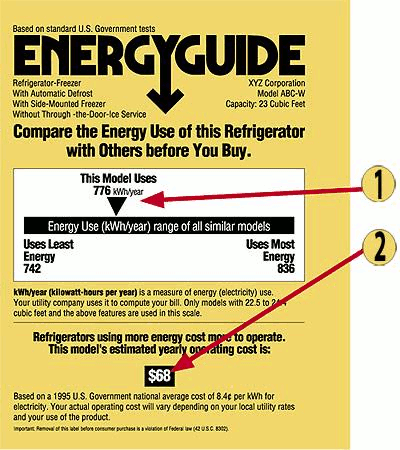Energy Star Refrigerator
Save $500 or more!
We strongly advise you to buy an Energy Star Refrigerator or Energy Star Freezer.
Since these refrigerators consume less energy, you will do a good deed by burdening our over polluted environment less plus you can easily SAVE $500 or more by buying one! How?
See the points below:
- An Energy Star refrigerator on average saves you $20 worth of electricity cost per year compared to similar sized, non Energy Star unit. In 12 years, this comes to $240.
- Some utility companies, local communities and even manufacturers themselves offer up to $200 rebates (in some cases, particularly when buying several appliances, even more) for buying Energy Star appliances.
- $20 less of electricity which is converted to heat anyway, means less work for the air conditioner also – at least a $5 saving in electricity cost per year or $60 in 12 years.
So, you can get $200 (or more in some cases) in rebates immediately and then $25 worth of savings per year (for a total of $500 over 12 years) just by buying an equivalent, but Energy Star rated refrigerator. Not to mention you will end up with a better, more efficient refrigerator, with more advanced and quieter compressor, better door seals and insulation, more precise temperature and defrost systems, which will make you happy for years to come.
Since refrigerators are always on, even small improvements in efficiency and energy consumption have great effects in the long run.
If you have a very old unit(20 years or more), buying a new, Energy Star refrigerator can save you even more: for instance, an old side by side refrigerator consumes $300 or more worth of electricity per year! An equivalent Energy Star unit costs less than $60 per year to operate. The difference is a substantial $240 per year. This means a new equivalent side-by-side refrigerator will pay for itself in only 5 – 6 years with energy savings alone and even sooner with additional rebates available on www.energystar.gov.
Free heavy trash pick-up and even rebates for proper disposal or recycling of old units are also available.
Energy Star Logo:

Example 1:
We recently came across a small, cheap, compact freezerless refrigerator (about 3 cu. ft. capacity), which costs less than $100. Good bargain? Only until we looked at the nameplate at the back of the unit, with stated energy consumption of 1.2kWh per day. This comes to 438kWh or $47 per year in electricity cost and is comparable to a 22 cu. ft. top freezer Energy Star rated refrigerator, with 7 times the capacity and a freezer (remember the "el cheapo" was small and freezerless)! So, when buying, even if your budget is tight, do not go for the cheapest purchase price only, also consider running costs over refrigerator's lifetime (usually 10-15 years or more).
Example 2:
Put the old refrigerator in the basement? Better not. As stated above, the old fridge belongs to a proper recycling facility. Buy a bigger main fridge instead or if you must have it, a smaller, more efficient (yes, Energy Star again) unit – it will pay for itself very quickly due to lower electricity cost. The same is true for your weekend home, RV, boat etc.
Besides being green and saving money, by buying an Energy Star refrigerator you will also send a strong message to manufacturers (and their engineers) that their efforts to develop better and more efficient refrigerators were not in vein.
Energy Guide
According to Federal law, all appliances for sale need to have the yellow Energy Guide labels attached. The labels list the refrigerator's running costs = estimated yearly electricity consumption (in kWh) and cost, based on average electricity price. This is a sample refrigerator Energy Guide label:

1: Refrigerator's yearly energy consumption (in kWh), compared to other refrigerators in the same class (= same type & size). Best in class (lowest consumption) on the left, worst on the right side. The more on the left your refrigerator is, the better.
2: Estimated yearly running costs based on average electricity price (also listed on the label).
For Energy Star qualified refrigerators, the Energy Star logo is also included on the label.
Energy Star Refrigerator Reviews
KitchenAid KSRP25FSSS Side by Side Refrigerator ReviewKitchenAid KSRP25FSSS Refrigerator is certainly worth checking out for anyone in the market for a new fridge. Why? For starters, this model is considered to be among the most popular refrigerators in the market today and you would not want to miss the chance to see what the commotion is all about.
KitchenAid KBFS20EVMS Architect Series II French Door Refrigerator Review
The KitchenAid KBFS20EVMS is part of the KitchenAid Architect Series II freestanding French door refrigerator models with a total refrigeration capacity of 19.7 cubic feet, including both refrigerator and freezer. Intelligently designed to meet everyone's refrigeration needs it is also a kitchen stand-out with its chic design. You can improve the way you keep your food fresh and safe with the model's numerous compartments and ample space for all types of food and beverage that requires refrigeration.
Electrolux EI26SS55GS Side by Side Refrigerator Review
Electrolux EI26SS55GS refrigerator can meet all your fresh and frozen food storage requirements while guaranteeing reliability. Manufactured by one of the leading names in appliances, you will not even think twice about purchasing a unit once you have seen what it can offer.
Amana AFD2535FES French Door Stainless Steel Refrigerator Review
The purchase of major kitchen appliances such as an Amana AFD2535FES is indeed something you should be very careful about. After all, you would not want to invest in something and realize too late that you could have been better off with another brand. One of your first considerations should be the manufacturer.